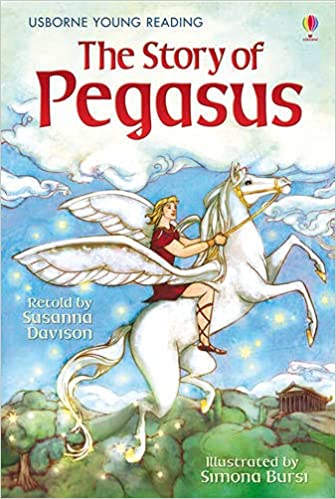Title of the work
Country of the First Edition
Country/countries of popularity
Original Language
First Edition Date
First Edition Details
Susanna Davidson, The Story of Pegasus. Nomad Press, Usborne Books, 2011, 48 pp.
ISBN
Genre
Myths
Picture books
Target Audience
Children (5 years and older)
Cover

Courtesy of the publisher.
Author of the Entry:
Ayelet Peer, Bar-Ilan University, ayelet.peer@gmail.com
Peer-reviewer of the Entry:
Lisa Maurice, Bar-Ilan University, lisa.maurice@biu.ac.il
Susan Deacy, University of Roehampton, s.deacy@roehampton.ac.uk

Simona Bursi (Illustrator)
Simona Bursi is a freelance illustrator. She trained in applied art and animation at the Institute of Art in Urbino, Italy. She has worked for several TV stations and for a number of publishing houses in Italy and beyond. The works she has illustrated in English include Black Beauty, The Usborne Book of Greek Myths and Story of Pegasus.
Source:
Milan-illustrations (accessed: August 1, 2022).
Bio prepared by Sonya Nevin, University of Roehampton, sonya.nevin@roehampton.ac.uk and Susan Deacy, University of Roehampton, s.deacy@roehampton.ac.uk

Susanna Davidson (Author)
Susanna Davidson is a British author of over fifty fiction and non-fiction books for children, written mostly for Usborne Publishing. Her publications include retellings of traditional myths and fairy tales, such as Cinderella (Usborne), Rapunzel (Usborne), The Story of Pegasus (Usborne), Baba Yaga the Flying Witch, and Little Red Riding Hood (Usborne). Susanna Davidson also writes children's books on religion and history, including The Story of Hannukah (Usborne), The Holocaust (Usborne), and Elizabeth I (Usborne), as well as other non-fiction titles such as Snails (Usborne), Penguins (Usborne), and Under the Ground (Usborne). Under the name "Zanna Davidson", she writes modern children's fiction, including the Fairy Ponies and Fairy Unicorns series.
Bio prepared by Sonya Nevin, University of Roehampton, sonya.nevin@roehampton.ac.uk
Summary
This book retells the story of Bellerophon and Pegasus and how they fought the Chimera. At the end of the story, Bellerophon rides Pegasus to Olympus. Zeus, angry at this audacity, sends an insect to sting Pegasus and makes Bellerophon fall to the ground. Pegasus then remains with the gods while Bellerophon becomes a lone wanderer. After Pegasus' death he is placed among the stars.
The short text is accompanied by full-page colourful illustrations. On the back page it is written that the story of Pegasus is a myth from ancient Greece and it is explained that he sprang from the neck of Medusa and roamed wild until meeting Bellerophon.
Analysis
The book follows the myth of Bellerophon, an ancient myth already narrated in the Iliad (6.144ff). Bellerophon receives the magic bridle from the goddess Athena and can hence harness the magical Pegasus. In this version of the story, when Bellerophon wakes up and discovers the bridle, he thinks "Pegasus could be mine!" (p. 19), a comment which may insinuate that Bellerophon may not be too caring or emphatic regarding Pegasus, and treats him more as a tool than a companion. Their initial encounter also appears quite violent. When Bellerophon witnesses Pegasus drinking at a stream, he quickly "slipped the bridle over the horse's head. Pegasus reared up, beating the air with his powerful wings." (p. 22). While later Bellerophon does whisper calming words to Pegasus until the horse drops to the ground, their first encounter does not feel in any way friendly. Bellerophon tells the horse: "you're mine now…let's ride together" (p. 24). This does not seem like a shared friendship but rather a master and servant. This story is in contrast with Marianna Mayer's Pegasus book, which accentuated the mutual respect and trust between the two. This story appears to aim to portray Bellerophon's conceit.
The pair then fight the Chimera (which is described as a deadly monster, made of lion, goat and a snake), with the final illustration showing a bloody Chimera lying killed on the ground (the text reads "dead at last") and the figure of Bellerophon raising his fist up, shouting "victory" (p. 36). This scene appears violent, although the Chimera is depicted as a frightening monster, yet the drawing of the dead lion’s head may appear as an unsettling image for some readers.
Bellerophon's arrogance continues when he announces to the king that he had done the impossible. The people cheer and shout "you're a hero…you're like a god" (p. 39). This applause makes Bellerophon wonder, "'Maybe I am a god', thought Bellerophon, swelling with pride" (p. 40). Yet Bellerophon is severely punished for his pride (or hybris) by literally, and metaphorically, falling from Olympus and becoming a despised wandered while Pegasus receives respect from the gods. Hence, in the end, Pegasus receives the reward he was due for his bravery.
Despite the moral message noted above, one can detect an ecological message as well, regarding fair treatment of animals.
Addenda
The review refers to the Kindle edition 9781409584940.


